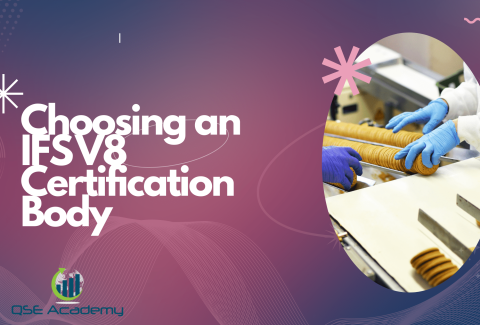IFS V8 Certification Timeline in 6 Steps
Last Updated on November 19, 2025 by Melissa Lazaro
Understanding the Real Timeline (Experience-Backed)
One of the first questions companies ask when exploring IFS certification is: “How long does it take?” And the honest answer is—it depends. Every organization has a different starting point, different product risks, and a different level of system maturity. But there is a predictable rhythm to the process once you understand the key milestones.
After working with businesses across sectors—bakeries, meat processors, beverage manufacturers, logistics hubs, and brokers—I’ve seen timelines range from three months to over a year. The difference usually comes down to preparedness, internal ownership, and how early the certification body is secured.
If you’re here, you’re probably trying to plan resources, align departments, or avoid rushing right before the audit. By the end of this guide, you’ll have a realistic view of every step, the time it typically requires, and where delays most often happen. That clarity helps you plan—not just react.
Step 1 — Gap-Analysis & Scoping (2–6 Weeks): Know Where You Stand
Everything starts with understanding your current state. The gap-analysis isn’t just a checklist; it’s where you map your business against the full IFS V8 requirements and determine which product categories and modules apply.
This step includes:
- Reviewing current policies, HACCP plans, and procedures
- Confirming which processes and product ranges fall under scope
- Identifying gaps in documentation, training, validation, and evidence
A solid scope prevents headaches later—especially when dealing with product risk categories and audit-duration calculations.
Pro Tip: Include production, quality, and leadership during scoping. When only QA handles it, blind spots appear fast.
A common mistake at this stage is assuming an existing FSMS (like ISO 22000 or BRCGS) means the system already meets all IFS expectations. There’s overlap—but not equivalence.
 Step 2 — System Development & Documentation Update (4–16 Weeks): Build What’s Missing
Step 2 — System Development & Documentation Update (4–16 Weeks): Build What’s Missing
Once the gaps are clear, you fill them. This is where most of the heavy lifting happens—especially if your documentation or process controls need restructuring.
Typical tasks include:
- Updating procedures and standard operating instructions
- Establishing monitoring records and traceability logs
- Aligning documentation style and numbering
- Updating PRPs, product specifications, risk assessments, and HACCP
The timeframe varies depending on how mature your existing system is. Some clients only need tweaks; others essentially build a structured QMS from scratch.
One client cut their documentation timeline in half simply by assigning document owners. When responsibility is clear, momentum follows.
Pitfall: Copying templates word-for-word without adjusting to what you actually do. Auditors will spot disconnects instantly.
Step 3 — Implementation & Staff Training (4–12 Weeks): Make the System Real
This is the point where procedures stop being documents and become routines.
Activities include:
- Rolling out updated procedures
- Completing records in real time
- Conducting food-safety and role-specific training
- Running traceability or recall tests
- Verifying monitoring logs and calibration routines
In my experience, this phase separates “paper systems” from working systems. Training also isn’t just ticking attendance sheets—it’s about building competence.
Pro Tip: Short, frequent training sessions are often more effective than long theory-heavy workshops.
Many teams wait too long before training, hoping to “finalize everything first.” That delay usually creates a bottleneck.
Step 4 — Internal Audit & Management Review (2–6 Weeks): Test Before the Auditor Arrives
Once the system is running, you perform a full internal audit based on IFS V8—not a simplified checklist version.
This phase ensures:
- Non-conformities are identified early
- Records are complete and accessible
- HACCP and risk controls are functioning
- Data is ready for management review discussions
Management review must show decisions, actions, and resource planning—not just minutes from a meeting.
Pro Tip: Treat internal audits like rehearsals. The closer it feels to the real audit, the fewer surprises later.
One company avoided a major NC because their internal auditor flagged missing allergen-validation evidence. Catching gaps here saves time, stress, and sometimes money.
Step 5 — Certification Body Onsite Audit (1–3 Days): The Official Assessment
Once everything is ready, the certification body conducts the onsite audit. Depending on scope, size, and risk category, the audit may take one to several days.
Expect:
- Plant tours
- Document and record reviews
- Staff interviews
- Traceability tests
- HACCP validation checks
- Verification of prerequisite and operational controls
The best audits feel calm because the system is routine—not staged.
Pro Tip: Organize records logically (by process or clause) so retrieval is fast and stress-free.
A common mistake is treating the audit as a performance rather than a demonstration of everyday operations.
Step 6 — Corrective Actions & Certification Decision (2–12 Weeks): Final Close-Out
Once the audit is complete, you’ll receive the report listing any non-conformities. You then submit evidence showing how each gap will be corrected.
The faster and clearer the response, the sooner the certification body can finalize the decision.
Typical timing:
- Minor NCs: corrective action response in days or weeks
- Major NCs: may require re-audit depending on severity
- Certification issuance: once evidence is accepted
Pro Tip: Assign each corrective action immediately after the closing meeting—before momentum fades.
Once approved, the certificate is issued and added to the IFS database.
FAQs — Timeline & Planning Questions Answered
Can we fast-track the certification process?
Sometimes. It depends on system maturity, team availability, and how quickly a certification body can schedule an audit.
When should we book the certification body?
Earlier than most companies think—ideally during documentation development, not after everything is “ready.”
Does having another GFSI certification shorten the timeline?
Often yes—but only if the system is well-maintained and staff are trained.
Conclusion — Your Timeline Is Now Clear Enough to Plan With Confidence
Now you have a realistic view of how long IFS V8 certification takes, what happens at each step, and where delays tend to occur. Whether your path takes three months or a year, clarity makes it manageable.
If you’d like help mapping your actual timeline, I can create a customized version based on your scope, size, and current readiness—or share a ready-to-use project worksheet to kickstart planning.
Melissa Lavaro is a seasoned ISO consultant and an enthusiastic advocate for quality management standards. With a rich experience in conducting audits and providing consultancy services, Melissa specializes in helping organizations implement and adapt to ISO standards. Her passion for quality management is evident in her hands-on approach and deep understanding of the regulatory frameworks. Melissa’s expertise and energetic commitment make her a sought-after consultant, dedicated to elevating organizational compliance and performance through practical, insightful guidance.








